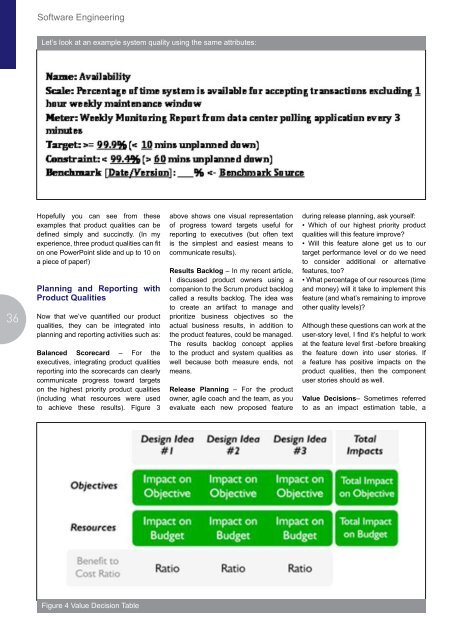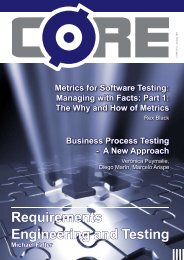Comparison of Change Management Systems
Comparison of Change Management Systems
Comparison of Change Management Systems
You also want an ePaper? Increase the reach of your titles
YUMPU automatically turns print PDFs into web optimized ePapers that Google loves.
36<br />
S<strong>of</strong>tware Engineering<br />
Let’s look at an example system quality using the same attributes:<br />
Hopefully you can see from these<br />
examples that product qualities can be<br />
defined simply and succinctly. (In my<br />
experience, three product qualities can fit<br />
on one PowerPoint slide and up to 10 on<br />
a piece <strong>of</strong> paper!)<br />
Planning and Reporting with<br />
Product Qualities<br />
Now that we’ve quantified our product<br />
qualities, they can be integrated into<br />
planning and reporting activities such as:<br />
Balanced Scorecard – For the<br />
executives, integrating product qualities<br />
reporting into the scorecards can clearly<br />
communicate progress toward targets<br />
on the highest priority product qualities<br />
(including what resources were used<br />
to achieve these results). Figure 3<br />
Figure 4 Value Decision Table<br />
above shows one visual representation<br />
<strong>of</strong> progress toward targets useful for<br />
reporting to executives (but <strong>of</strong>ten text<br />
is the simplest and easiest means to<br />
communicate results).<br />
Results Backlog – In my recent article,<br />
I discussed product owners using a<br />
companion to the Scrum product backlog<br />
called a results backlog. The idea was<br />
to create an artifact to manage and<br />
prioritize business objectives so the<br />
actual business results, in addition to<br />
the product features, could be managed.<br />
The results backlog concept applies<br />
to the product and system qualities as<br />
well because both measure ends, not<br />
means.<br />
Release Planning – For the product<br />
owner, agile coach and the team, as you<br />
evaluate each new proposed feature<br />
during release planning, ask yourself:<br />
• Which <strong>of</strong> our highest priority product<br />
qualities will this feature improve?<br />
• Will this feature alone get us to our<br />
target performance level or do we need<br />
to consider additional or alternative<br />
features, too?<br />
• What percentage <strong>of</strong> our resources (time<br />
and money) will it take to implement this<br />
feature (and what’s remaining to improve<br />
other quality levels)?<br />
Although these questions can work at the<br />
user-story level, I find it’s helpful to work<br />
at the feature level first -before breaking<br />
the feature down into user stories. If<br />
a feature has positive impacts on the<br />
product qualities, then the component<br />
user stories should as well.<br />
Value Decisions– Sometimes referred<br />
to as an impact estimation table, a



